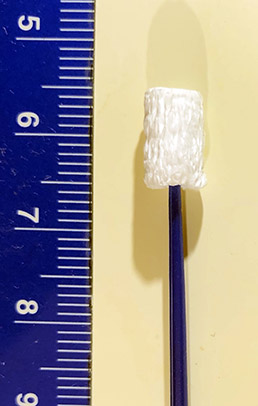Rapid diagnosis of COVID-19 is essential for early treatment, contact tracing and reducing viral spread. However, some people infected with SARS-CoV-2 receive false-negative test results, which might put them and the health of others at risk.
 |
A UNMC team developed this ultra-absorptive nanofiber swab. |
A UNMC team developed an ultra-absorptive nanofiber swab that could reduce the number of false-negative tests by improving sample collection and test sensitivity.
The team’s findings are published in the American Chemical Society’s Nano Letters.
The most sensitive test currently used for COVID-19 involves using a long swab to collect a specimen from deep inside a patient’s nose, and then using a method called reverse transcriptase-polymerase chain reaction (RT-PCR) to detect SARS-CoV-2 RNA. But if the viral load is low, which can occur early in the course of infection, the swab might not pick up enough virus to be detectable.
“Using nanoscale fibers, instead of micro scale fibers, we have created extremely absorptive swabs that can detect SARS-CoV-2 at very low concentrations and reduce false negative tests,” said Jingwei Xie, PhD, associate professor, UNMC Department of Surgery-Transplant and Mary & Dick Holland Regenerative Medicine Program. “We have been investigating the use of these materials and noting their remarkable absorptive properties and our ability to control their shape, and we thought to repurpose them as swabs.”
The researchers used an electrospinning technique to make 1-cm-long cylinders composed of aligned nanofiber layers, which they coated with a thin layer of gelatin and bonded to plastic swab sticks. In lab tests, the porous nanofiber cylinders absorbed and released more proteins, cells, bacteria, DNA and viruses from liquids and surfaces than the cotton or flocked swabs commonly used for COVID-19 testing.
The team made dilutions of SARS-CoV-2 virus, swabbed the liquid samples and tested for viral RNA with RT-PCR. Compared with the two other types of swabs, the nanofiber swabs reduced the false-negative rate and detected SARS-CoV-2 at a 10-times lower concentration. The researchers report that nanofiber swabs also have potential in diagnosing other diseases, testing for foodborne illnesses and helping forensic teams identify crime suspects from miniscule biological specimens.
“If there is interest in commercialization of the swabs, they may be used to detect trace amounts of biological samples,” Dr. Xie said. “T he largest potential for the swabs is in early detection of pathogens and in forensics; both avenues are viable for research and commercialization.”
Funding was provided by UNMC, the National Institute of General Medical Sciences and the UNMC College of Medicine COVID-19 Rapid Response Grants.
